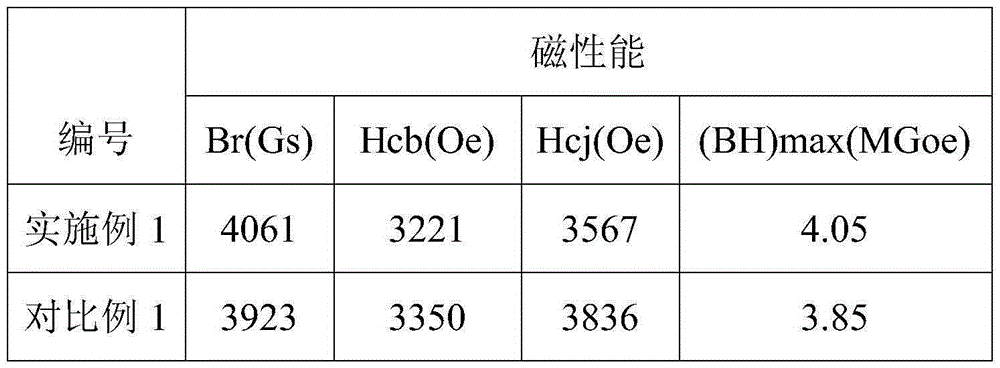Method for manufacturing dry press permanent magnetic ferrite
A technology of permanent magnet ferrite and manufacturing method, which is applied in the field of magnetic materials, can solve the problems of limitation of promotion of permanent magnet ferrite, easy cracking of blanks, and low orientation degree of dry pressing magnetic field, and achieves optimization and improvement of particle size and morphology of magnetic powder. Magnetic properties, the effect of improving yield
- Summary
- Abstract
- Description
- Claims
- Application Information
AI Technical Summary
Problems solved by technology
Method used
Image
Examples
Embodiment 1
[0023] Select the Y38 calcined material on the market, add some required additives according to the mass ratio, and carry out ball milling. The time is 15 hours and the rotation speed is 30r / min. Store the slurry obtained in the above steps at 110° C. until it is dried, and the average size of the particles is about 1.2 μm. After drying the magnetic powder, add 0.4% calcium stearate and 1.2% alcoholic camphor solution (camphor: alcohol = 1:1), and disperse it with a high-speed pulverizer after mixing evenly. The magnetic powder was put into a mold and molded in a magnetic field of 8000Oe with a molding pressure of 4MPa to obtain a molded body with a diameter of 5cm and a height of 1.6cm. The green body was kept at 350°C for 3 hours to remove calcium stearate, and then kept at 1150°C for 3 hours to obtain a ferrite sintered magnet. After grinding and cleaning, the magnet was kept at 23°C for 24 hours, and then the magnetic properties were measured to obtain Br=4061Gs, Hcb=3221...
Embodiment 2
[0030] Select the Y38 pre-fired material on the market, add some required additives according to the mass ratio, and carry out ball milling for 12 hours at a speed of 50r / min. Store the slurry obtained in the above steps at 110° C. until it is dried, and the average size of the particles is about 1.2 μm. After drying the magnetic powder, add 0.5% calcium stearate, 1.0% alcoholic camphor solution, and 0.2% talcum powder, and disperse it with a high-speed pulverizer after mixing evenly. The magnetic powder was put into a mold and molded in a magnetic field of 8000Oe with a molding pressure of 5MPa to obtain a molded body with a diameter of 5cm and a height of 1.5cm. The green body was kept at 400°C for 1 hour to remove calcium stearate, and then kept at 1350°C for 0.1 hour to obtain a ferrite sintered magnet. After grinding and cleaning, the magnet was kept at 23°C for 24 hours, and then the magnetic properties were measured to obtain Br=4103Gs, Hcb=3245Oe, Hcj=3612Oe, (BH)max=...
Embodiment 2 and comparative example 2
[0033] The magnetic property of table 2 embodiment 2 and comparative example 2 magnet
[0034]
[0035] Table 2 shows the magnetic properties of the magnets obtained in Example 2 and Comparative Example 2. It can be seen from Table 2 that adding 0.2% talc powder helps to improve the remanence and the molding pass rate. As a dispersant, talc powder can reduce the friction between dry powders, play a buffering effect, help magnetic field orientation and improve molding rate.
PUM
| Property | Measurement | Unit |
|---|---|---|
| Average size | aaaaa | aaaaa |
| Diameter | aaaaa | aaaaa |
| Average size | aaaaa | aaaaa |
Abstract
Description
Claims
Application Information
 Login to View More
Login to View More - Generate Ideas
- Intellectual Property
- Life Sciences
- Materials
- Tech Scout
- Unparalleled Data Quality
- Higher Quality Content
- 60% Fewer Hallucinations
Browse by: Latest US Patents, China's latest patents, Technical Efficacy Thesaurus, Application Domain, Technology Topic, Popular Technical Reports.
© 2025 PatSnap. All rights reserved.Legal|Privacy policy|Modern Slavery Act Transparency Statement|Sitemap|About US| Contact US: help@patsnap.com



